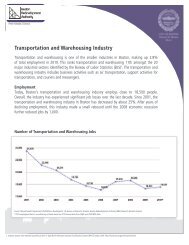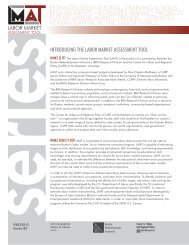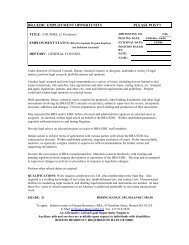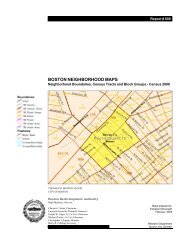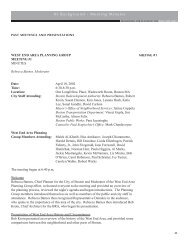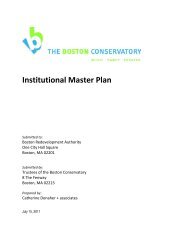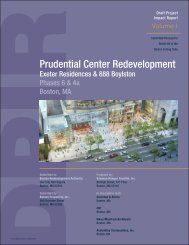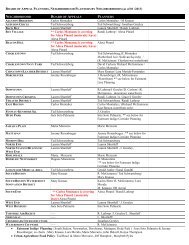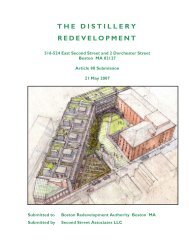point cover jan 13 - Boston Redevelopment Authority
point cover jan 13 - Boston Redevelopment Authority
point cover jan 13 - Boston Redevelopment Authority
You also want an ePaper? Increase the reach of your titles
YUMPU automatically turns print PDFs into web optimized ePapers that Google loves.
\\MABOS\projects\1<strong>13</strong>81.00\reports\Article80\<br />
Expanded_PNF\04_Environmental_FINAL.do<br />
c<br />
Vanasse Hangen Brustlin, Inc.<br />
The Point, <strong>Boston</strong><br />
Height is also an important factor in collision avoidance. The Project is well below the primary migration<br />
zone for all sizes of birds, which varies between 300 and 2,000 feet. The major zone for potential collision at<br />
this building is, therefore, below 60 feet. The Project’s two retail floors are setback to the residential tower<br />
within the first 60 feet of building height. This break greatly mitigates the potential for collision at the upper<br />
range of this 60ft zone. Below this break, less reflective glass will be used, further ensuring bird safety at this<br />
lower range of this zone. In addition, retail awnings and signage inherently help alert passing birds to<br />
potential collision.<br />
Air Quality<br />
This section presents an overview of the results for the air quality assessment conducted for the Project. The<br />
purpose of the air quality assessment is to demonstrate that the Project satisfies applicable local, state, and<br />
federal air quality requirements. Specifically, the air quality assessment for the Project includes a localized<br />
(microscale, or “hot spot”) study that evaluates the Project-related concentrations (from vehicles traveling<br />
through congested intersections in the project area) of carbon monoxide (CO) and particulate matter (PM2.5<br />
and PM10) at sensitive receptor locations.<br />
<br />
Summary of Key Findings<br />
The Project Site is located in the <strong>Boston</strong> Metropolitan area, which has been classified as a “Maintenance” area<br />
for CO and an attainment area for PM10 and PM2.5. The microscale (“hot spot”) air quality analysis<br />
demonstrates that the Project will meet and is well below the Massachusetts DEP criteria and National<br />
Ambient Air Quality Standards (NAAQS) for CO, PM10, and PM2.5. The Project will incorporate reasonable<br />
and feasible mitigation measures, including a Transportation Demand Management (TDM) Plan, as<br />
presented in Chapter 3, Transportation to reduce vehicle emissions. Appendix E includes the support<br />
documentation for the air quality analyses. Regarding new heating boilers and emergency generators, the<br />
Proponent will apply for any DEP air permits, as required by DEP regulations under 310 CMR 7.00.<br />
<br />
Background<br />
The 1990 Clean Air Act Amendments (CAAA) and the Massachusetts State Implementation Plan (SIP) require<br />
that proposed projects not cause any new violation of the NAAQS for pollutants of concern, or increase the<br />
frequency or severity of any existing violations, or delay attainment of any NAAQS. The air quality study<br />
includes a hotspot (microscale) evaluation of mobile source pollutants. The microscale analysis evaluated CO,<br />
PM10, and PM2.5 concentrations from roadways and intersections.<br />
The Environmental Protection Agency (EPA) and Massachusetts Department of Environmental Protection<br />
(DEP) have established guidance for modeling and review for air quality analysis prepared pursuant to the<br />
Massachusetts Environmental Policy Act (MEPA) process. The City of <strong>Boston</strong> requires that air quality<br />
analyses prepared for PNFs meet the EPA and DEP guidelines.<br />
4-15 Environmental Protection



